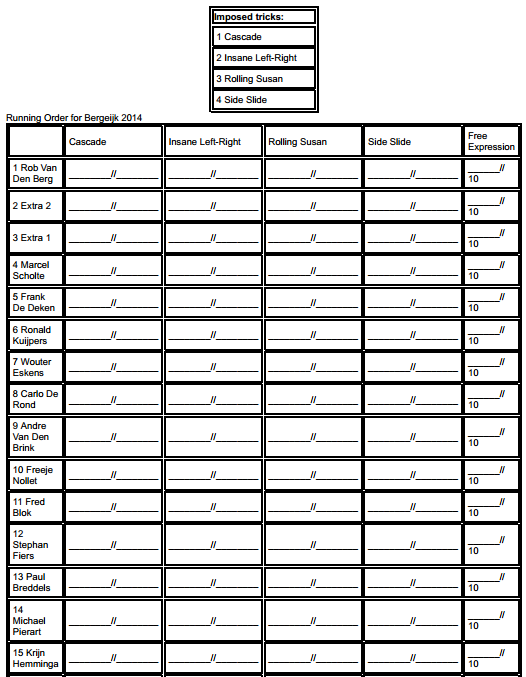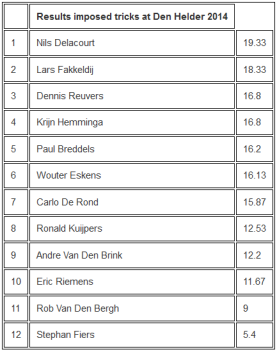Judging: Imposed Tricks
 The first thing judges do on competition day is determine which tricks will be the imposed tricks of the day. Normally there is an International list of 8 up to 10 tricks that is set for the whole season. This allows pilots to train for these, as some of the imposed tricks are not in their ballet routine. According to the wind conditions, the 3 judges and the Field Director choose the 4 most suitable to be performed and judged. These tricks are announced in a "pilots briefing" just before the start.
The first thing judges do on competition day is determine which tricks will be the imposed tricks of the day. Normally there is an International list of 8 up to 10 tricks that is set for the whole season. This allows pilots to train for these, as some of the imposed tricks are not in their ballet routine. According to the wind conditions, the 3 judges and the Field Director choose the 4 most suitable to be performed and judged. These tricks are announced in a "pilots briefing" just before the start.
Each judge gets a copy of the running order and imposed tricks, that may look something like the sized down example on this page. Each pilot has two minutes to perform the 4 tricks in order. If the pilot wants to, he can have a second try at a trick before attempting the next in the list.
The pilots have to call "IN" when they start a trick and preferably "OUT" when finished.
The judges will evaluate the attempt and give a score from 1 (for trying) up to 10 (when the trick is executed perfectly). Those pilots who skip a trick get 0 for that trick, or when then run over time, also 0 for the tricks they didn't do.
That said, how do they judge a trick? It's best to break a trick down into 3 components: the IN, the movement itself, the OUT. All this is different from trick to trick. So a judge needs to know what to look for in each of the components. As each judge has his/her own way of judging, things may be slightly different from one to another, but in general they judge rather close in range. After a while, a judge doesn't think anymore in components, but has the experience to "feel" what a right score is. For beginners, it is best to think this way to have something to fall back to if in doubt.
IN: if a pilot messes up his IN completely, you can think 0. If it was close to perfect, think 2. Anything in between is 1. Let's take the well known AXEL as an example for this. We know that the AXEL starts from a STALL and the kite has to be nose-up; if a pilot does a nice visible stall and has the kite nose up, you should think 2 for the IN. If he does a stall halfway decent, or/and the kite hangs a bit to one side, think 1. If he doesn't do a stall but starts the AXEL from a moving position, it's more like 0.
The trick itself: the kite should do a full 360° rotation on it's belly, with at least the nose-away position absolutely flat. In this case, "flat" means that nose and two wingtips are parallel to the ground. Also, the rotation should be complete, the kite should rotate untill the nose is pointing towards the pilot. For the points here, you have a 6 points margin. If any of the key elements is missing, you may subtract points for that. Let's say the rotation is flat indeed, but only 300°, you can subtract 2 points (or whatever you think is justified). If all is perfect, it's 6 points!
OUT: For the AXEL, that's a straight line UP. It's easy to see that a rotation short of 360° will never get a straight line UP immediately.You will see most pilots flying OUT a little sideways and correct that to UP and straight. Here's 1 point enough. If a pilot flies out sideways, 0 it is. If the rotation was full, the pilot will be able to fly straight up in a nice straight line (something like 2 meters is enough).
Now you can add the parts and come to an overall score. Most tricks will rack up 6 and 7, but to go higher they need to perform very well in all parts. Tricks messed up are in the range of 3 and 4, because they do have some things right (let's hope). If a trick isn't completed, say the AXEL was initiated after a stall but the kite gets in a wingwrap and crashes, that's where the score will be 1.
Now each judge can go over the trick list and see what the components are for each trick. The above is not the one and only way to judge, but is helpfull in the beginning of your judging carreer. Something to fall back to if you are unsure about a certain trick. It's one of the reasons why we like the imposed tricks to be set for a whole season, judges can come fully prepared to the competition field.
As a bonus, we have a .pdf file from the early days in Tricksparty where we tried to write down what we did on the field. Things are a bit different now. But you can understand why we never gave 10 for a trick and even EXCELLENT was seldom on our score-sheets. You can download the doc here: scoringTP (mostly put together by Harold Slit)
On this page we have as an example the results from a past competition. As you know that 40 points is the absolute maximum, it's easy to see that most scores are way below that.  There's a reason for that: we only had two judges that day, so the results should be one third higher on average. Nils Delacourt should have gotten 28.99 and so on (if you need to know: divide by 2 and multiply with 3). When we have a proper sheet we will change this one ;-) Overall, one could state that this is a seperate competition for technical skills. No need to fly to music, just 4 tricks in 2 minutes. The tricks are the same for all pilots, so it's a fair way of comparing pilots. Most of the time, the chosen tricks aren't the hardest to do. That's because we have all levels of pilots in the same competition: the European champion flies before a guy who does his first competition, newbies and veterans fly in the same conditions. So we get the imposed tricks from the lower difficulty groups.
There's a reason for that: we only had two judges that day, so the results should be one third higher on average. Nils Delacourt should have gotten 28.99 and so on (if you need to know: divide by 2 and multiply with 3). When we have a proper sheet we will change this one ;-) Overall, one could state that this is a seperate competition for technical skills. No need to fly to music, just 4 tricks in 2 minutes. The tricks are the same for all pilots, so it's a fair way of comparing pilots. Most of the time, the chosen tricks aren't the hardest to do. That's because we have all levels of pilots in the same competition: the European champion flies before a guy who does his first competition, newbies and veterans fly in the same conditions. So we get the imposed tricks from the lower difficulty groups.